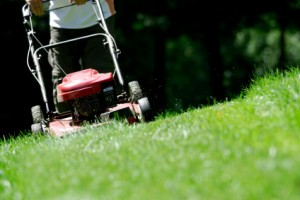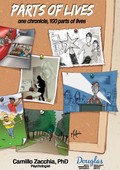The Helen tree
(Voir plus bas pour la version Française: L’arbre d’Hélène)
One weekend, while mowing my lawn and working my way around a particular tree, I thought about an argument I had with a woman named Helen. I quickly forgot about the incident and finished my lawn. The following Saturday I was back behind my lawnmower. When I came to the same tree I vividly remembered the argument and felt the same churning in my guts. This feeling lasted for a few moments and went away. The problem is it kept coming back every time I mowed around the Helen tree.
It’s hard to tell if it was the sight of the tree alone, or the sound of the motor, or the vibrations in my arms, or a combination of all these stimuli that did the trick, but the association between the emotions evoked by that memory and the act of mowing around the Helen tree was now part of my brain’s wiring.
This is a simple example of a learned association. Many of you may know about Pavlov’s dogs and how they began to salivate at the sound of a bell that rang when someone entered the lab. Over time the bell became associated with mealtime. Did you ever walk by a bakery and have the smell remind you of visiting Grandma when you were a kid? Or hear a song on the radio that made you feel like you were in your high school gym waiting to dance? Almost any sight, smell, sound, or association with a past event, can trigger a flashback. It’s as if we are temporarily transported back in time.
Learned associations can often be pleasant reminders of people or events from the past. They last a few moments and then disappear. Unfortunately, we can just as easily have negative reminders. We all remember where we were on the morning of September 11, 2001. If you were ever in a car accident or assaulted, you will also get flashbacks. People who suffer from panic attacks often develop associations to the sights and sounds of each attack. Even after treatment when they no longer fear panic, the smell from the grill, or the clinking of glasses, or even the ambient lighting, can trigger old sensations of anxiety.
Negative flashes should be just as brief as the pleasant ones. The problem is we don’t treat them the same. We enjoy the pleasant ones, smile and let them pass naturally. The bad ones would normally pass just as quickly except for the fact we tend to question and analyze them. “Why did that happen? Are my panics coming back? What could I have done differently?” This fruitless questioning creates new anxieties. It keeps the flashback going and chips away at our confidence.
A natural process must run its course. Negative associations and memories are unpleasant enough. But they are nothing more than emotional memories triggered by any number of stimuli that happen to have become associated with them. They don’t have a profound significance. Treat them as unpleasant reminders and just let them be. If we don’t fight their natural occurrence, they will do the same as the pleasant ones; pass quickly. They will get briefer and occur less often. It is when we worry about getting them and make assumptions about their meaning that they strengthen and continue to plague us for a long time.
(For more on this topic, here is an older post: Pavlov rears his ugly head)
__________________________________________________________________________
Voici la version Française (Source: Journal Métro, 25 septembre, 2012)
Un samedi, alors que je tondais le gazon, j’ai songé à une dispute que j’avais eue avec une femme prénommée « Hélène » pendant que je contournais un des sapins qui est dans ma cour. J’ai oublié cet incident et terminé l’entretien de ma pelouse. Le samedi suivant, de retour derrière ma tondeuse, j’ai aperçu l’arbre, et je me suis rappelé nettement la dispute; mon estomac s’est alors serré de nouveau. Cette sensation a duré quelques secondes, puis s’est dissipée. Le problème, c’est qu’elle revenait à chaque fois que je tondais le gazon autour de cet arbre. Je le nomme maintenant « l’arbre d’Hélène ».
Voilà un exemple simple d’une association acquise. Plusieurs d’entre vous ont entendu parler des chiens de Pavlov, qui commençaient à saliver dès qu’une cloche annonçait l’arrivée de quelqu’un dans le laboratoire. Avec le temps, les chiens en sont venus à associer la cloche à l’heure du repas. Vous est-il déjà arrivé, en sentant l’odeur d’une boulangerie, de vous revoir, enfant, chez votre grand-maman? Ou d’entendre une chanson à la radio et de vous revoir dans le gymnase de votre école… attendant votre premier « slow »? Pratiquement tout ce qu’on peut voir, sentir, entendre ou associer à un événement passé peut déclencher un flash-back, comme si nous étions temporairement transportés dans le temps.
Les associations acquises sont souvent des rappels agréables de gens ou d’événements du passé. Elles durent quelques instants, puis se dissipent. Malheureusement, ces rappels peuvent aussi être désagréables. Nous nous rappelons tous où nous étions, le matin du 11 septembre 2001. Si vous avez subi un accident de la route ou une agression, vous aurez également des flash-backs. Les gens qui souffrent de crises de panique créent souvent des associations liées à ce qu’ils ont vu et entendu au cours de chaque attaque.
Les flash-backs négatifs devraient être aussi brefs que ceux qui sont agréables. L’ennui, c’est que nous ne les traitons pas de la même façon. Nous prenons plaisir à revivre ceux qui sont agréables, nous sourions et les laissons se dissiper naturellement. Ceux qui sont négatifs disparaîtraient aussi rapidement, mais nous avons tendance à les analyser : « Pourquoi est-ce arrivé? Mes crises de panique reviennent-elle? Qu’aurais-je pu faire de différent? » Cette vaine remise en question crée de nouvelles anxiétés, perpétue les flash-backs et mine notre confiance.
Un processus naturel doit suivre son cours. Les associations et les souvenirs négatifs sont désagréables, mais si nous ne s’y attardons pas, ils feront comme les flash-backs agréables : ils passeront rapidement. Ils seront de plus en plus courts et moins fréquents. C’est lorsque nous sommes préoccupés par leur apparition et que nous échafaudons des hypothèses qu’ils se renforcent et continuent de nous tourmenter pendant longtemps.
Tagged as classical conditioning, learned associations, Post-Traumatic Stress Disorder.
Posted in Human nature.
Posted on 25 Sep 2012


On Sep 27th 2012 at 19:16
C’est toujours un grand plaisir que de vous lire!
On Oct 4th 2012 at 23:02
Allo Cam, Pourquoi ne pas renommer ton arbre. L’arbre des Hélène. Ça te ferait aussi penser à toutes les autres Hélène avec qui tu as tant de plaisir. Ça pourrait même te motiver davantage à tondre ton gazon.
D’une autre Hélène, la ricaneuse qui te trouve très cool.